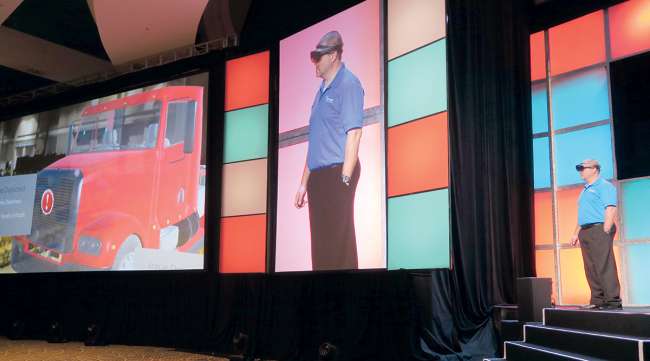Managing Editor, Features and Multimedia
PeopleNet Explores Augmented Reality in Trucking, Wearable Tech for Drivers, Remotely Piloted Trucks

NASHVILLE, Tenn. — Trucking technology supplier PeopleNet envisions a future when truck drivers might wear virtual-reality goggles to perform data-enhanced vehicle inspections while dispatchers monitor their fleets in a 3D context rather than simply viewing dots on a computer screen.
These potential uses of augmented reality — adding virtual sensory inputs to enhance views of the physical world — are among the next-level technologies that PeopleNet is actively exploring.
Other futuristic concepts on the company’s radar screen include technology that would enable drivers to remotely operate unmanned, autonomous trucks from the comfort of their offices as well as wearable technology that could reduce distracted driving and track driver health.
While these ideas might seem far off, they are becoming possible through the convergence of technologies such as holographic computing, artificial intelligence, automated driving and 5G wireless communication, Chief Technology Officer Mark Botticelli said here Aug. 14 at PeopleNet and TMW Systems’ In.sight user conference.
PeopleNet and TMW are part of Trimble’s transportation and logistics division.
While PeopleNet offered no timeframe for introducing augmented reality as part of a commercial offering, Botticelli said he sees a lot of potential.
“The more we work with it, the more we realize how viable it is,” he said.
To demonstrate the augmented reality concept, Jim Lowell, PeopleNet’s chief software engineer, wore a Microsoft HoloLens headset to interact with a virtual truck by walking around a hologram of the vehicle during the conference’s opening session.
Someday, dispatchers and safety managers might be able to interact with trucks out in the field in a similar manner.
“They can do it with their monitors, but we think this brings a whole new element and really gives them context,” Botticelli said.
Drivers, meanwhile, might wear augmented-reality goggles while performing pre- and post-trip vehicle inspections. This could augment the walk-around with richer data and enable the driver to view key information in context, including maintenance history for various components.
PeopleNet presented its augmented reality concept by integrating the HoloLens into SketchUp, a 3D computer modeling firm that Trimble purchased from Google in 2012.
The goal of the demonstration, Botticelli said, was to stimulate ideas on how augmented or “mixed” reality might benefit the transportation industry.
PeopleNet also continues to monitor the growth of wearable technologies.
The company already has developed software for the Apple Watch as part of its ConnectedDriver mobile applications.
“Wearables have become more readily available, affordable and now provide rich sensor data,” which companies can use for predictive and prescriptive analytics, Botticelli said.
A smart armband that detects muscle motion, for example, could help eliminate driver distraction by allowing the driver to simply gesture rather than interacting with displays in the cab.
Shirts that capture biometric information also could make their way into trucking operations as that technology improves.
“We believe that’s going to be an important breakthrough for predicting driver fatigue before they know they’re getting tired,” Botticelli said.
Looking further ahead, PeopleNet also defined a role that it could someday play in an autonomous trucking ecosystem.
While PeopleNet doesn’t intend to develop autonomous driving systems, the company could focus on “solving some of the problems that autonomy can create,” Botticelli said.
When automated driving technology advances to the point where trucks can operate themselves without a driver on major shipping lanes, PeopleNet could provide technology that enables human drivers to remotely take control of those trucks during the more complex portions of the journey.
“We believe that human drivers can remotely pilot these trucks as they enter into city limits … or in complicated terrain or environmental conditions,” Botticelli said.
A remote driver working from a local operations center could sit in a “pod” that is connected to the real truck out on the road. That pod would provide haptic feedback to simulate the feel of the vehicle moving and the curve of the road, for example.
The ability to virtually swap drivers in and out of vehicles would boost operational efficiency for carriers while providing drivers with more home time and alleviate the growing driver shortage, he said.
Starsky Robotics, a Silicon Valley-based startup, also is pursuing a vision of remotely piloted trucks.
Botticelli, however, argued that remotely operated trucks will require more advanced, 5G wireless communications networks to transmit the necessary amount of data.
“There are a lot of technologies that have to converge for this to become a reality,” he said.

